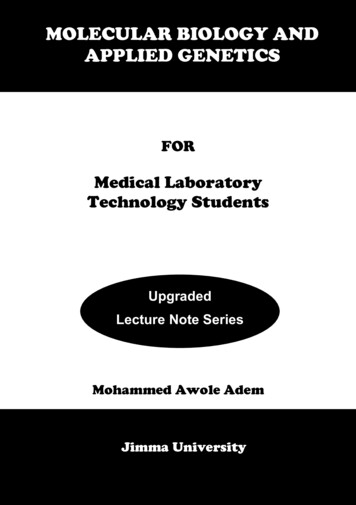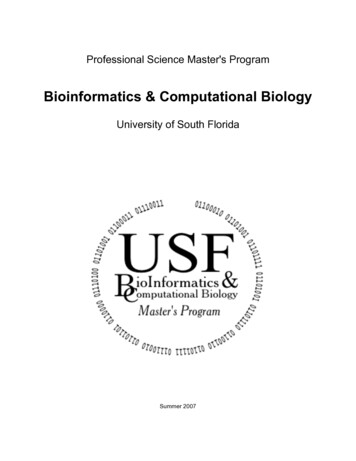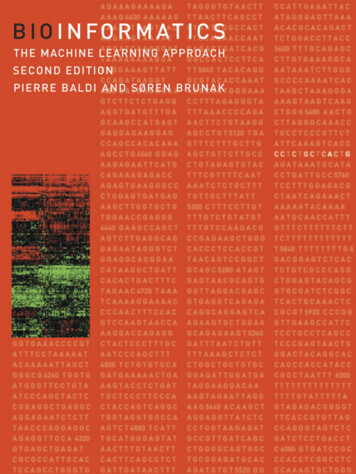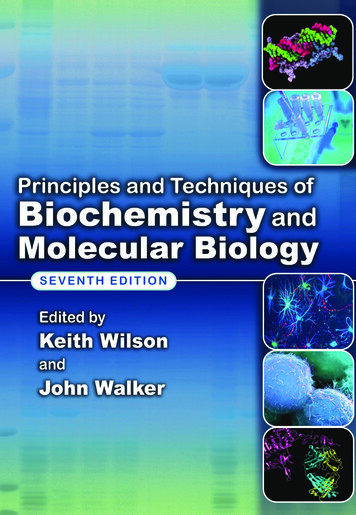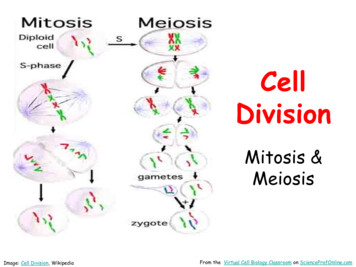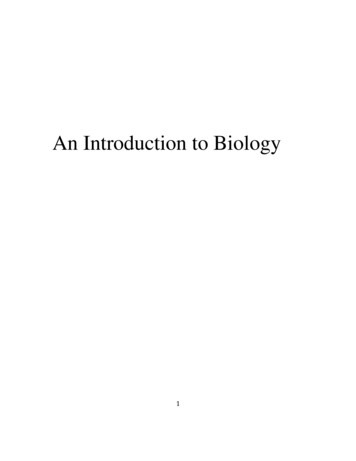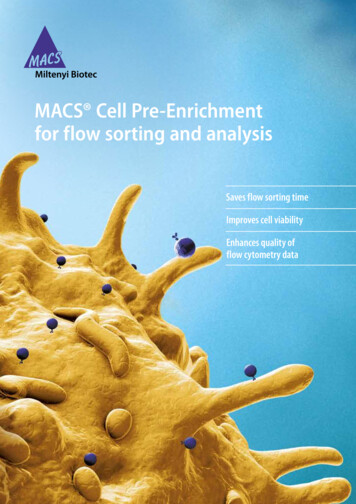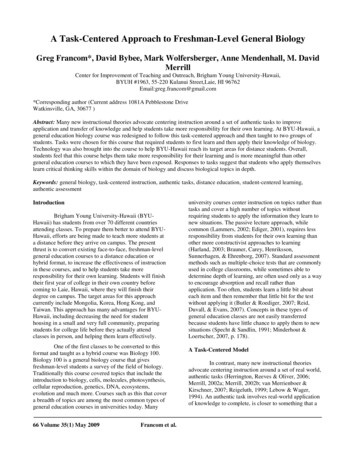
Transcription
Introduction to Cell & Molecular Biology Lab (BIOL111L)Common SyllabusThis is a foundation course for biology majors provides an introduction to cell and molecular biology. In the first semesterof this introductory lab sequence we will explore important biological concepts and processes, but do so in a way that willhelp you to develop the scientific and critical thinking skills that form basis for the practice of science and use of scientificknowledge for understanding and evaluating contemporary topics in biology.The lab curriculum is structured to gradually give you more practice doing various aspects of science, and culminates in amulti-week team project in which you will be engaged in the entire process of proposing, designing, conducting, writing,and presenting a scientific research project of your own design. In this way you will experience not only the power thatscience has to reveal the workings of the natural world, but also the dynamic nature of this knowledge.During lab, you will be working in small teams on several experiments over the course of the semester. For most labs youwill have individual responsibilities for preparing for the coming week’s laboratory. These involve homework assignments,textbook readings, outside research or tutorial review. Your individual preparation for lab will be essential for the successof the whole team. Your final grade in this lab course will be based on a combination of your grades on both individualand team assignments. Successful completion of Biol 111/111L (or 151 & 151L) & Biol 112/112L (or 152 & 152L) fulfills thegeneral education natural science requirements at the College of Charleston.Team Grades – These are grades given to each member of the team and are based on work that all members of theteam collaborated on. Team grades are given for the Team Lab Notebook (TLN) completed for each lab, along withother work done by the team during lab. Please be aware that the lab instructor can adjust these grades based oneach person’s lab preparation, participation, and contribution as reflected by peer evaluations which you willcomplete each week. Those who participated/contributed will receive the full worth of the team’s grade; those whodid not contribute fully will only receive partial credit. The guidelines for completing the weekly peer evaluationsare in the Student Forms Appendix in your lab manual. Look over this carefully so that you understand yourresponsibilities to your teammates for lab.Individual Points – These are grades given to each member of the team and are based on work that is to be doneindividually. Some of the labs require that each member of the team write the discussion (or conclusions) of the labseparately. Often there will be a quiz at the start of each lab. Quizzes will cover the previous lab, andreading/homework to be done in preparation for that day’s lab. There is also pre-lab homework to be completedprior to most labs. Table 1 lays out the percent each assignment category counts toward your final lab grade. Notethat the grade categories are color coded and correspond with the schedule of assignments (Table 2).Table 1. Percent of final grade by grade categoryGrade CategoryTeam Lab Notebooks & other team lab work (Team)Quizzes & other individual work (Individual)Homework (Individual)Final Independent Project Article (Individual)*Attendance, Participation & Progress (Individual)Percent of FinalGrade25%30%10%25%10%*This grade is subjective and based on your lab instructor’s assessment of your individualcontribution to your team, prompt and regular attendance to lab, effort, preparation for lab,and improvement over the course of the semester.
Table 2. Schedule of Assignments, Quizzes and ReadingsWeekAug 31OnlineLabLab 1 – Termite TrailsQuizzes1Homework---Lab 2 – Osmosis & Diffusion: Part 1TLN Lab 2 – Part 1Sept 21- Lab 2 – Osmosis & Diffusion: Part2- Lab 3 - Exploring PlantMetabolismLab #2 TLN – Part 2Lab 3 TLNSept 28Lab 4 (Week 1) – ExploringMetabolic Diversity: What FactorsEffect Plant Productivity?TLN Lab 4:Week 1 Plant MetabolismJournalOct 5- Lab 4 (Week 2) – ExploringMetabolic Diversity: The ResearchProposal;- Lab 5 (Week 1): Exploring theGenetics of Eye Color in Fruit Flies- TLN Lab 4:Week 2- Team Proposal- Proposal PeerEvaluationOct 12Oct 19Oct 26Nov 2Nov 9Nov 16- Lab 4 (Week 3) – ExploringMetabolic Diversity: DataCollection- Lab 5 (Week 2): Genetics of EyeColor in Fruit Flies- Lab 4 (Week 4) – ExploringMetabolic Diversity: ContinuingData Collection & Analysis- Lab 5 (Week 3): Genetics of EyeColor in Fruit Flies- Lab 6 - Lost in Timbuktu- Lab 4 (Week 5) – ExploringMetabolic Diversity: Draft ArticlePeer Review- Lab 5 (Week 4): Genetics of EyeColor in Fruit FliesLab 5 – Genetics of Eye Color inFruit Flies (Week 5) – DrosophilaGeneticsLab 7 – Genetics & MolecularBiology of Sickle Cell AnemiaTLN Lab 4:Week 3-Lost in TimbuktuTLN (Lab 6)-TLN Lab 4: Week 4- Draft Article PeerReviews & ScribeSummariesFly Genetics TLN(Lab 5)Sickle Cell TLN(Lab 7)Nov 23Nov 30OnlineStudent Project Oral Presentations- Oral PresentationQuiz #1 over coursesyllabus & safetyInferential StatisticsQuiz #2-Quiz #3: Lab 3: PlantMetabolismQuiz #4: Osmosis &Diffusion---Quiz #5 over Lab 6(Lost in Timbuktu)- Quiz #6 over Lab 5(Fruit Fly Genetics)-Pre-lab #2 Osmosis LabWorksheet Questions(lab manual pg. 11)Inferential StatisticsSummary Table (labmanual pg. 24); andReaction TimeWorksheet (pg. 25-26)-Lab #2 Osmosis –Conclusions (see labmanual pg. 28-29)-Plant MetabolismWorksheet Questions(lab manual pg. 37-38)-Post-lab reading:- Lab Manual Appendices B & C (pp. 137150)Pre-lab Reading:- Textbook– Chapter 5Pre-lab Readings- Lab manual Appendix D: Inferential Statistics- Textbook: Chapter 6.1, 6.4, 7.1, 8.1- OAKS Tutorials: Overview of Energetics & CellularRespiration Overview of Photosynthesis Using a CO2 Sensor to Estimate PrimaryProductivity in PlantsPre-Lab Tutorial:- Plant Metabolism & Productivity Tutorialon OAKSPre-lab Reading/Research:- Background biological research on thequestion you posed in Lab 4: Week 1.- Read Lab 5 Weeks 1-3: Exploring theGenetics of Fruit Fly Eye Color (pp. 65-71)--- Pre-lab Reading: Guide to Scientific Writing (Lab ManualAppendix E) Textbook Ch. 12 (pp. 313-322)-Pre-lab Readings:- Lost in Timbuktu: Read The Scenario andComplete the Pedigree Analysis (pg. 8487).- Textbook Ch. 3.4-3.5; Ch 12 (pp. 323-325);Ch 17 (pp. 439-444).- - Lab 6 OAKS Tutorial: Gel ElectrophoresisIndependent ProjectsDraft Article Due toOAKS by Sunday Nov. 1Pre-lab Reading:- Textbook Ch.6.5- Lab 5: Week 4 & 5 (Lab Manual pg. 71-81)Pre-lab 7 Worksheet(lab manual pg. 103104)Thanksgiving Break – No Labs this Week- Sickle Cell Letter (seelab manual pg. 119) –Final IndependentDue Dec. 7Project Article- Project PresentationPeer ReviewHomework is listed on the week it is due. Homework is due at the start of lab.1Readings & Tutorials-Termite Trails rewrite (see lab manual pg. 4-5) – DUE TO the OAKSDropbox by Friday, Sep. 11.No Labs this WeekSept 7Sept 14Individually Earned PointsTeam EarnedPointsPre-lab Readings:- Textbook Ch 12 (pp. 325 -339)Pre-lab Reading:- Lab 7: Part 1 – Meeting the Affected Family(pg. 105-107)- Lab 7 OAKS Tutorial: Mutations- Textbook Ch. 15-
Quizzes will be over concepts from the previous week’s lab, and homework reading for that day’s lab. All work is gradedon a 100 point scale.Lab Grade Determination – BIOL 111L is a 1-credit course. The lab grade is separate from the 3-credit class grade.Letter grades in lab will be assigned according to the following percentages of total points earned. AAB BBC 93-100 %90-9287-8983-8680-8277-79 CCD DDF73-7670-7267-6963-6760-62Below 62Attendance is very important to your success in lab. If you miss a lab for an excused reason (medical illness, family emergency, CofCathletics conflict), you must arrange with your lab instructor to make up the lab in another lab section.As a College of Charleston student, you are expected to do your best to ensure the health and safety of yourself, your peers, and theCollege of Charleston faculty and staff. We strongly urge all students to take the COVID-19 Cougar Pledge. If you have, or suspectthat you have contracted COVID-19, you should self-isolate and/or quarantine as per the College of Charleston guidelines.General guidelines for making up a missed lab: In the event that you must miss a lab for a legitimate reason, you must do everything possible to contact your instructor inadvance of your lab meeting, preferably at least 24 hours in advance, so that special accommodations can be made inarrangement with your lab instructor. These accommodations may include one of the following:o Attending another lab section if space allowso Attending and participating in your scheduled lab section virtually if you feel well enough to do so.o When possible, completing the lab individually at another scheduled time and/or at home. You may not attend (virtually or in person) another lab section without explicit permission of your lab instructor! If you attend another lab section, you are responsible for submitting the Team Lab Notebook (TLN) and/or any otherassignments to the respective OAKS assignment dropboxes for your regularly scheduled lab section for grading. Consult your lab section’s syllabus for further information on makeup policies specific to your lab section.During the COVID-19 pandemic you are not required to provide documentation justifying that an absence meets the criteria for beingexcused; however you are expected to abide by the College of Charleston Honor Code with regard to reporting an absence as alegitimate excused absence. You should also be aware of the significant consequences for lying about such matters. Absences thatyou admit to being unexcused will result in a 0 (zero) for that week’s lab assignments. However in such cases, it will still be worthwhileto contact your lab instructor to find out what post-lab assignments you can complete and what you can do to be prepared for thefollowing week’s lab.If you have more than one unexcused absence, you must either withdraw from lab or you will receive a failing grade (F). Note that ifyou choose to withdraw from the lab, you must also withdraw from the lecture class since the lab and class are co-requisites. Finally,if you are forced to completely miss three or more labs for health-related reasons, you should contact your lab instructor as soon aspossible. In such cases it may be possible to withdraw from the lab, without having to withdraw from the lecture class, and to discussarrangements for re-taking the lab in a subsequent semester.Required Textbooks
Discovering Biological Science: Laboratory Manual for Biology 111 7th Ed., by John S. Peters and Brian G.Scholtens, Hayden-McNeil.Since labs will begin online, it is preferable that you purchase a digital manual through the College bookstore.Alternatively, if you prefer a bound hard copy, it can be purchased at the College Bookstore and shipped toyour home prior to the start of the term. However, supplies of bound copies are limited. Do not purchaseused manuals or older editions of the manual.OpenStax: Biology, 2nd Edition. This is an Open Access Textbook. There are several FREE options to view thetext (online, pdf, Kindle, OpenStax App) or you can order a print copy ( 40- 50) from Amazon or the CollegeBookstore.Disability ServicesThe College will make reasonable accommodations for persons with documented disabilities. Students should apply for services atthe Center for Disability Services/SNAP located on the first floor of the Lightsey Center, Suite 104. Students approved foraccommodations are responsible for notifying your lab instructor as soon as possible and no later than one week beforeaccommodation is needed.Use of the OAKS course management systemOAKS, including Gradebook, will be used for this course throughout the semester to provide the syllabus and class materials andgrades for each assignment, which will be regularly posted.Recording of Classes (via ZOOM)At the discretion of your lab instructor, online labs may be recorded via both voice and video recording. By attending and remainingin this lab, you (the student) consents to being recorded. Recorded class sessions are for instructional use only and may not be sharedwith anyone who is not enrolled in the class.Mental & Physical WellbeingAt the college, we take every students’ mental and physical wellbeing seriously. If you find yourself experiencing physical illnesses,please reach out to student health services (843.953.5520). And if you find yourself experiencing any mental health challenges (forexample, anxiety, depression, stressful life events, sleep deprivation, and/or loneliness/homesickness) please consider contactingeither the Counseling Center (professional counselors at http://counseling.cofc.edu or 843.953.5640 3rd Robert Scott Small Building)or the Students 4 Support (certified volunteers through texting "4support" to 839863, visit http://counseling.cofc.edu/cct/index.php,or meet with them in person 3rd Floor Stern Center). These services are there for you to help you cope with difficulties you may beexperiencing and to maintain optimal physical and mental health. Information on how to maintain your health and wellness duringthe COVID-19 pandemic can be found at lness/index.php.Food & Housing ResourcesMany CofC students report experiencing food and housing insecurity. If you are facing challenges in securing food (such as not beingable to afford groceries or get sufficient food to eat every day) and housing (such as lacking a safe and stable place to live), pleasecontact the Dean of Students for support (http://studentaffairs.cofc.edu/about/salt.php). Also, you can go ing-insecurity/index.php to learn about food and housing assistance that is availableto you. In addition, there are several resources on and off campus to help. You can visit the Cougar Pantry in the Stern Center (2nd
floor), a student-run food pantry that provides dry-goods and hygiene products at no charge to any student in need. Please alsoconsider reaching out to one of your Professors if you are comfortable in doing so.Honor Code and Academic IntegrityPlagiarism in this class – The structure of this class is probably going to be different from that of other science classes you have taken.In this class we will, to a large extent, be working in small teams, much like professionals do when they collaborate on projects. Thecollaborative work we do in this class is meant to encourage you to work together with your teammates to help each other learn. Thiswill require that you share, justify and evaluate the ideas expressed among your teammates. So in short, you are allowed to worktogether on labs in this class. Working together means identifying knowledge your team needs to proceed, sharing researchknowledge and resources, evaluating each other’s ideas about methods, analysis and conclusions & providing constructive feedbackto your teammates. However, for some assignments you will be asked to work on them individually. When you write for theseassignments, the ideas you express will of course be a collection of those constructed by your team and supported by backgroundresearch, but what you write should ultimately be written individually, by you, and in your own words. Any information, concepts,ideas that you acquire from outside research sources must be summarized/explained in your own words, and appropriately cited (bothin a work cited section and parenthetically in the body of the paper). In short, this class will be structured to allow you to work togetherto form your ideas, but you must ultimately express these ideas in your own words! In fact, I hope you come to realize that the act ofexpressing and justifying your ideas is learning!Therefore the following constitutes what is and is not plagiarism in this classPlagiarismCopying ideas constructed by another member of yourteam, from the class, or from other students who havetaken this class in the past.Copying (essentially word for word) the ideas (information,findings, analysis, and conclusions) expressed in a researchresource (article, web site, textbook)Summarizing information or ideas expressed in a researchresource (i.e. a research article or web site) without citingthe source. Without a citation, you are implying that theideas are yours, when they are not!Using, in whole or in part, papers written for other classesto write an assignment for this class, without obtainingprior permission from the instructor.Quoting – Although not technically plagiarism, it isunacceptable in this class to begin by presenting ideas,concepts, findings, as quoted text, even if you provide acitation.Proper use of sourcesSummarize the ideas expressed by team or class members in yourown words. Use these ideas to justify your solutions, conclusions orrecommendations.Summarize the thoughts expressed in the research resource in yourown words. Use these ideas to justify your solutions, conclusions orrecommendations and cite the source.Cite your research using APA citation style formatting bothparenthetically, and in a Works Cited section at the end of thepaper. Citing your sources is always required, unless otherwisespecified in the assignment guidelines!If you have written a paper for another class which relates to aproject we are working on, talk with your instructor about what youcan and can’t use!Instead, FIRST explain, summarize or paraphrase information/ideas/concepts/findings that you get from research resources in your ownwords, and cite the source. ONLY use word for word quotes tosupport or drive home an idea or argument that you have alreadypresented in your own words from research or your own findings.Lying, cheating, attempted cheating, and plagiarism are violations of our Honor Code that, when suspected, are investigated. Eachincident will be examined to determine the degree of deception involved.Incidents where the instructor determines the student’s actions are related more to misunderstanding and confusion will be handledby the instructor. The instructor designs an intervention or assigns a grade reduction to help prevent the student from repeating theerror. The response is recorded on a form and signed both by the instructor and the student. It is forwarded to the Office of the Deanof Students and placed in the student’s file.Cases of suspected academic dishonesty will be reported directly by the instructor and/or others having knowledge of the incident tothe Dean of Students. A student found responsible by the Honor Board for academic dishonesty will receive a XXF in the course,
indicating failure of the course due to academic dishonesty. This status indicator will appear on the student’s transcript for two yearsafter which the student may petition for the XX to be expunged. The F is permanent.Students can find the complete Honor Code and all related processes in the Student Handbook denthandbook/
Introduction to Cell and Molecular Biology/Evolution, Form, and Function ofOrganismsBIOL 111 & 111L/BIOL 112 & 112LDepartment: BiologyLearning Goals & ObjectivesThis general education science sequence provides a background for understanding andevaluating contemporary topics in biology. Students develop a foundational understandingof core concepts to use and on which to expand in upper level courses. They also developthe critical competencies that form the bases for the practice of science and use of scientificknowledge.Core ConceptsThis 2-semester course sequence in general biology addresses fundamentalprinciples in biology to prepare students for sophomore and upper level courses inbiology: EVOLUTION: The diversity of life evolved over time by processes ofmutation, selection, and genetic change. The theory of evolution by naturalselection allows scientists to understand patterns, processes, andrelationships that characterize the diversity of life.STRUCTURE AND FUNCTION: Basic units of structure define the function ofall living things. Structural complexity, together with the information itprovides, is built upon combinations of subunits that drive increasinglydiverse and dynamic physiological responses in living organisms.Fundamental structural units and molecular and cellular processes areconserved through evolution and yield the extraordinary diversity ofbiological systems seen today.INFORMATION FLOW, EXCHANGE, AND STORAGE: The growth andbehavior of organisms are activated through the expression of geneticinformation at different levels of biological organization and depend onspecific interactions and information transfer.PATHWAYS AND TRANSFORMATIONS OF ENERGY AND MATTER: Biologicalsystems grow and change by processes based upon chemical transformationpathways and are governed by the laws of thermodynamic and will beexplored to understand how living systems operate, how they maintainorderly structure and function, and how physical and chemical processesunderlie processes at the cellular level (i.e. metabolic pathways, membranedynamics), organismal level (i.e. homeostasis) and ecosystem level (i.e.nutrient cycling).SYSTEMS: Living systems are interconnected and interacting and biologicalphenomena are the result of emergent properties at all levels oforganization, from molecules to ecosystems to social systems. The coursewill explore the dynamic interactions of components at one level ofbiological organization to the functional properties that emerge at higherorganizational levels.
The specific topics covered in each course include:Biology 111 & Biology 111L Chemical and physical properties of lifeCell form & functionEnergetics, metabolism, and photosynthesisThe cell cycleo Mitosis and cell reproductiono Meiosis and sexual reproductionMendelian genetics / Patterns of inheritanceHuman InheritanceThe molecular basis of inheritanceDNA and protein productionRegulation of gene expressionSome aspects of biotechnologyBiology 112 & Biol 112 L The development of evolutionary thinkingBasic evolutionary processesComparative plant form & functionComparative animal form & functionCore Competencies Nature of Scientific Knowledgeo Understand the intellectual standards used by scientists to establish the validityof knowledge, evidence, and decisions about hypothesis & theory acceptance.These standards include: 1) science relies on external and naturalisticobservations, and not internal convictions; 2) scientific knowledge is based onthe testing of hypotheses and theories, which are under constant scrutiny andsubject to revision based on new observations; 3) the validity of scientificallygenerated knowledge is established by the community of scientists throughpeer review and open publication of work.o Understand that new ideas in science are limited by the context in which theyare conceived; are often rejected by the scientific establishment; sometimesspring from unexpected findings; and usually grow slowly, through contributionsfrom many investigators.o Understand that science operates in a world defined by the laws of chemistryand physics.o Understand the differences and relationships among scientific theories,hypotheses, facts, laws, & opinions.o Understand the differences between science and technology, but also theirinterrelations.o Understand the dynamic (tentative) nature of science. Scientific Methods of Discovery
1Understand the methods scientists use to learn about the natural world(observing; questioning; formulating testable deductive hypotheses; controlledexperimentation when possible; observing a wide range of natural occurrencesand discerning (inducing) patterns).o Apply physical/natural principles to analyze and solve problems.Develop a Scientific Attitudeo Develop habits of mind that foster interdisciplinary and integrative thinking(within biology; between biology and other sciences; between science and otherdisciplines).o Develop an appreciation for the scientific attitude - a basic curiosity aboutnature and how it works.Develop scientific analysis and communication skillso Develop quantitative reasoning skills (quantitatively expressing the results ofscientific investigations, or patterns in nature and using knowledge of biologicalconcepts to explain quantitatively-expressed data or patterns).o Understand the probabilistic nature of science and the use/application ofinferential statistics to test hypotheses.o Develop scientific information literacy (library, internet, databases etc ); findand evaluate the validity of science-related information.o Communicate scientific knowledge, arguments, and ideas in a variety ofdifferent contexts (scientific, social, cultural), utilizing a variety of differentmedia (scientific articles, policy statements, editorials, oral presentations etc.).o Develop cooperative problem-solving skills (working effectively in teams), butalso habits of mind and skills that foster autonomous learning.Develop an appreciation for the impact of science on society.o Develop an appreciation of humans as a part of the biosphere and the 2impactof biological science on contemporary societal/environmental concerns.o Knowledge of the history of the biological sciences and the influences of politics,culture, religion, race, and gender on the scientific endeavor.oSignature assignments for measuring learning outcomesLearning Outcome 1: Students apply physical/natural principles to analyze and solveproblems.This learning outcome is assessed using the poster (or scientific article) generated inBiology 112 lab as part of the multi-week student-directed independent research project. Inthis project students use data they collect (or has been collected in actual researchinvestigations) to test an hypothesis of their choosing. These projects may be themed, withall student groups addressing different aspects of a larger question, emphasizing theinterdependence of various research groups needed to address complicated problems. This1 This learning goal will be measured as part of the general education assessment. The specificlearning outcome to be measured is: Students can apply physical/natural principles to analyze andsolve problems.2 This learning goal will be measured as part of the general education assessment. The specificlearning outcome to be measured is: Students can demonstrate an understanding of the impact thatscience has on society.
multi-week project begins the class identifying what questions need to be addresses in thelarger problem. Individual student groups then become experts in these areas of the largerproblem. The smaller research teams develop a hypothesis, and write a research proposalto test their hypothesis. Students collect (or use already collected data), summarize andstatistically analyze the data, and draw conclusions.Learning Outcome #2 - Students demonstrate an understanding of the impact that sciencehas on society.Biology 112 lab Students produce a written document based on one of the case-based labs(examples - policy statement, article, stake-holder professional letter or poster) thatrequires them to research and apply biological knowledge or evidence to defend or critiquea proposed solution to a biology-related societal issue. Although the choice of the specificissue or proposed solution is course-section specific, some examples of potential issuesinclude exploring environmental/health impacts of genetically modified organismsthe use of performance enhancing drugs in sportsthe development of antibiotic resistance in disease organisms
Biology of Sickle Cell Anemia : Sickle Cell TLN (Lab 7) - Quiz #6 over Lab 5 (Fruit Fly Genetics) Pre-lab 7 Worksheet (lab manual pg. 103-104) Pre-lab Reading: - Lab 7: Part 1 – Meeting the Affected Family (pg. 105-107) - Lab 7 OAKS Tutorial: Mutations - Textbook Ch. 15 Nov 23 . Thanksgiving Br
